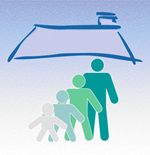Arthritis, 2009
Archived Content
Information identified as archived is provided for reference, research or recordkeeping purposes. It is not subject to the Government of Canada Web Standards and has not been altered or updated since it was archived. Please "contact us" to request a format other than those available.

The term 'arthritis' describes many conditions that affect joints, the tissue surrounding joints, and other connective tissue. The most common types are osteoarthritis and rheumatoid arthritis. The resulting pain, stiffness, swelling and/or deformity of the joints can substantially reduce quality of life.1
In 2009, 15.2% of Canadians 12 years and older—11.7% of males and 18.5% of females—reported having been diagnosed with arthritis, about the same as in 2008 (Chart 1).
Among both sexes, the percentage reporting arthritis increased with age. Females were more likely than males to have arthritis in all age groups (Chart 1).
The arthritis data are based on a question on the Canadian Community Health Survey that asked respondents if they had arthritis, excluding fibromyalgia.2
Chart 1
Percentage diagnosed with arthritis, by age group and sex, household population aged 12 and older, Canada, 2009

Source: Canadian Community Health Survey, 2009.
Residents of Quebec (10.6%) and Nunavut (7.7%—which should be interpreted with caution) reported lower rates of arthritis than the national average. Residents of Alberta, British Columbia, Yukon and Northwest Territories reported arthritis rates at about the national average; residents of the other provinces reported arthritis rates higher than the national average.
Because of the strong relationship between age and arthritis, a province or territory with a disproportionately 'younger' population would be expected to have an arthritis rate below the national average. Conversely, a province or territory with an 'older' population should have a higher arthritis rate than the national average. To remove the effect of different age distributions, the arthritis rates were recalculated as if the age groups in each province and territory were the same as at the national level. Based on these calculations, Quebec and British Columbia had arthritis rates lower than the rate for Canada. The age-standardized rates in Prince Edward Island, New Brunswick, Yukon, Northwest Territories and Nunavut were not significantly different from Canada; arthritis rates in the other provinces were higher than the national rate.
End notes
1.
The Arthritis Society. http://www.arthritis.ca (accessed May 10, 2010).
2. From 2001 to 2005, the survey question included the word "rheumatism."
References
The Arthritis Society http://www.arthritis.ca (accessed May 10, 2010).
Wilkins, Kathryn. 2004. "Incident arthritis in relation to excess weight." Health Reports. Vol. 15, no. 1. Fall. Statistics Canada no. 82-003. p. 39–49. /studies-etudes/82-003/archive/2004/6764-eng.pdf (accessed May 10, 2010).
Wilkins, Kathryn. 1999. "Hormone replacement therapy and incident arthritis." Health Reports. Vol. 11, no. 2. January. Statistics Canada Catalogue no. 82-003. p. 49–57. /studies-etudes/82-003/archive/1999/4735-eng.pdf (access May 10, 2010).
Data
Additional data from the Canadian Community Health Survey are available from CANSIM table 105–0501.
- Date modified:
